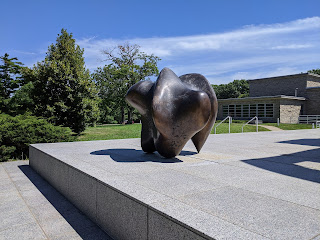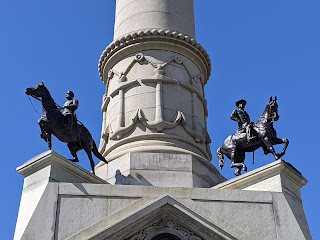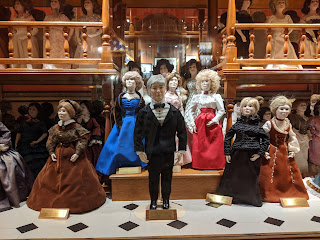Earlier that August day Steven and I had visited Lincoln, Nebraska's striking capitol building and the International Quilt Museum before driving 190 miles further east to Iowa's state capital city of Des Moines. The state's capital city came from the Des Moines River, which likely was adapted from the early French name, Rivière des Moines, meaning "River of the Monks." We headed directly to the Des Moines Art Center that has won international praise for its architectural style. The original building was designed in 1945 by Eliel Saarinen and then added onto in 1968 by I.M. Pei to house a collection of modern sculptures.
Though the building was unfortunately closed, we could see a beautiful Henry Moore sculpture on the grounds. I guess we'll have to wait to see any more until we visit the city again en route to see our granddaughter, Clara, in nearby Chicago.
Nearby was the Salisbury House and Gardens. Even though it, too, was closed, we climbed over the chain to get a better view of the entrance! The 42-room English manor home, designed after the 15th- century King's House in Salisbury, England, was finished in 1928 as the home for cosmetics magnate and art collector, Carl Weeks and his wife.
We headed next to the 1869 Victorian Second Empire mansion known as Terrace Hill, so called as it was built on a hill overlooking 8.5 acres. Built by Iowa's first millionaire, it was now the governor's residence.
Since we'd struck out at two closed attractions, we sought out the Des Moines Art Center's John and Mary Pappajohn Sculpture Park as the downtown 4.4-acre park had to be open, we figured! The park featured artwork by 25 of the world’s most celebrated artists.
IF you guessed these pieces by a British artist were both called Back of a Snowman, you'd win the grand prize! No matter of course how often we circled them, we were still always seeing them from the back which was quite a clever joke, I thought.
Seating for Eight, made of Deer Island granite in 1989 by American Scott Burton, was the only piece in the collection that could be touched, climbed on or sat on. That was good to know as in Burton's mind, his work was only complete when visitors were invited to use them. Notice the seats were in a 'democratic circle' as opposed to a hierarchical 'head of the table' arrangement. In the center was Burton's Café Table 1 made of polished black granite.
All the information signs were also in Braille which was very uncommon.
French-American Artist Louise Bourgeois created her oversized, bronze Spider sculpture in 1997. Bourgeois used colossal spiders in her work since the 1940s, seeing them, not as terrifying predators, but as a symbol for her beloved mother!
Who couldn't smile after seeing these mischievous faces called Moonrise January and August by a Swiss sculptor?! They were part of a series of a dozen sculptures with the same title.
What I found more alluring than some of the previous works was panoramic awareness pavilion by Dane Olafur Eliasson that was created specifically for the sculpture park. A lantern in the center was illuminated by a circle of 23 colored glass panes. I read that the artist envisioned the park "as an ocean with waves where the lantern's light can be used like a lighthouse for orientation and guidance."
My favorite piece was Nomade by Spaniard Jaume Plensa that only upon looking at it up close did I realize the 'skin' on the crouching figure was actually comprised of letters from the alphabet! If you click on the photo to make it larger, you can see that more easily for yourself. The work was an example of Plensa's "ongoing interest in ideas presented in written text." How I wish I had walked inside the sculpture and taken a photo there.
Another particularly happy piece was Three Dancing Figures, version C by Keith Haring, an American who died at the young age of just 32 in 1990. Though trained as a traditional artist, his primary subject was the human figure reduced to basic lines and primary colors, often dancing as in this sculpture.
Another perspective of Nomade:
Japanese artist Yayoki Kusama has always loved placing polka dots on pumpkins since growing up on her family's seed and plant nursery as "It seems pumpkins do not inspire much respect." She titled her 8-foot work Pumpkin (L).
Japanese pop art sculptor Yoshitomo Nara created White Ghost from fiberglass in 2010. Though it seemed to be just a playful cartoon character to me, I read that "his figures usually carry a dark or somber tone." These 'demon children' as they have been called are normally little girls, possibly because his parents had lost a daughter at birth and expected Nara to also be a girl.
It had been fun way walking around and exploring Des Moines' very impressive sculpture park even though I wasn't a big fan of many of the pieces. Too bad our adopted city of Denver can't lay claim to such a park.

The main reason Steven and I had come to Des Moines was to visit the city's state capitol in our quest to tour as many of them as possible. But, to Steven's chagrin, I got sidetracked by these two murals first!

Atop a large hill sat the capitol building surrounded by a landscaped 160-acre park with lots of monuments. The main dome was covered with 23-karat gold leaf! The gold leaf, though, was so thin that a quarter of a million sheets of it pressed together would only measure an inch thick.
A small version of the Statue of Liberty greeted us on the east side as we continued to walk around the capitol. Apparently a Kansas City businessman who had been active in Boy Scouts donated it in 1950. When it was cleaned in 2014, the formerly green patina turned almost white.
Construction of the brick and limestone capitol began in 1871 and was completed fifteen years later.
Janina: Some really pretty ceiling shots of the capitol's interior for you! As you and other frequent readers must know, I have become an ardent fan of grand ceilings since I first began photographing them years ago on our overseas travels.
The upper dome was a double shell with the interior shell visible from the main floor while the exterior shell could only be seen outside. The upper dome wasn't decorated and mainly designed to give maintenance workers access to the behind-the-scenes features of the dome.
Suspended across the dome was the emblem of the Grand Army of the Republic which was placed there as a reminder of Iowa's efforts to preserve the Union during the Civil War. When the capitol was recently renovated, a painted sky with clouds was added to the dome's interior.
A 1,350-pound model of the battleship USS Iowa that was on loan from the US Department of the Navy was on display near the rotunda.
Scagliola was imitation marble or granite that was used in columns throughout the capitol.
We're all accustomed to the first spouses being female but here in Iowa the first spouse was male so there was a different take on the doll collection in his case!
In previous years, Iowa's governors used the aptly named Grand Stairway, made of marble and granite, to take their official parties to inaugural balls.
Above the Grand Stairway was the mural painting by Edwin Blashfield called Westward which symbolized pioneers' arrival in Iowa.
Visible above us on the third floor were six glorious mosaics in arched panels that depicted Charity, Defense, Education, Executive, Judicial, and Legislative. Designed by Frederick Dielman who also created two mosaic panels in the Library of Congress in Washington, DC, the mosaics were made in Venice from small pieces of colored glass at a cost of $10,000.
The House Gallery:
What's not to love about this equally beautiful ceiling?!
The Senate Gallery:
The Supreme Court:
Do you remember reading about the horrific windstorm most of Iowa suffered in early August? We lucked out as we had arrived in Des Moines immediately afterward. Many traffic lights were still out and temporary stop signs had been installed in the middle of intersections, something we'd never come across before but assumed must be common in the city.
Steven and I are already planning to drive back to Chicago in mid-July for Clara's first birthday as long as we can receive vaccinations first. I hope we can stop in Des Moines again on the way and see what we unfortunately missed out this time.
Next post: Morton Arboretum in Chicago.
Posted on January 15th, 2021, from Phoenix, Arizona where we came for a couple of weeks to enjoy the sun and a change of pace from winter at home in Denver. Steven and I want you and your loved ones to be safe, healthy and connected during these challenging times. I hope you also are beginning to see light at the end of this long, dark tunnel.































































No comments:
Post a Comment